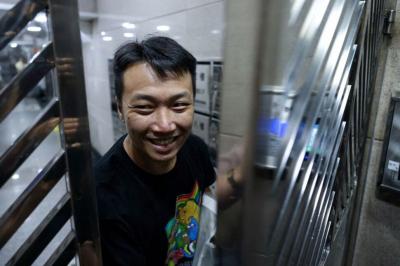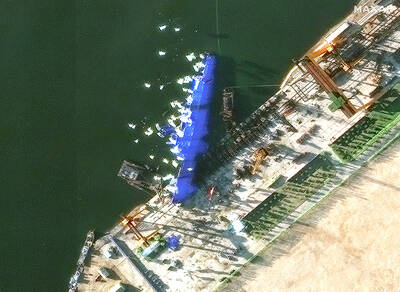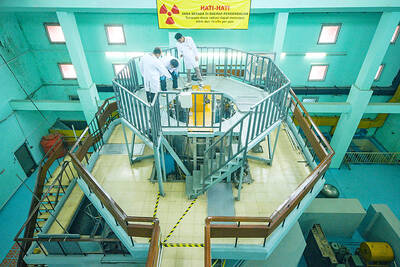What’s more expensive than the Beijing Olympics, covers a vast territory and is forcing countries and international companies to splash out millions of dollars? It’s China’s latest publicity project.
If China was serious about creating a legacy after the Beijing Olympics, it is outshining all its past efforts for the Shanghai World Expo, spending US$4.2 billion on reinventing the world’s exhibition fair as a blowout extravaganza.
While previous expos in Zaragoza and Hanover went largely unnoticed on the global agenda, Shanghai is creating such a promotional ruckus, that countries are going all-out to impress an expected 70 million visitors.
“It’s for countries to cozy up. For countries like Australia or France, it’s make-up money, a tribute to the emperor. They are apologizing for all the trouble caused in the last few years,” said Paul French, chief China analyst with retail consultancy Access Asia in Shanghai.
Of 191 countries attending, most are investing record amounts to build pavilions, with governments taking the lead in providing the bulk of investment and heads of state, including French President Nicolas Sarkozy, promising to make an appearance.
“The expo plays in the same league as the Olympic Games and the Soccer World Cup,” said Dietmar Schmitz, Germany’s Commissioner General at Shanghai World Expo.
Germany is spending US$67 million on its pavilion, which will let visitors sample traditional dishes like bratwurst sausage and Bavarian pork knuckle.
Saudi Arabia’s spaceship pavilion, which will feature desert date palms and a 1,600m² cinema screen — about a quarter the size of a soccer pitch — stands almost fully completed, gleaming against muddy construction rubble at adjacent unfinished sites.
The Saudi pavilion is the most expensive at US$146 million, while Australia is spending US$76 million and France is shelling out US$68 million.
China is the first developing nation to host the World Expo and officials hope the event, to be held from May 1 through Oct 31, will improve Shanghai’s position as a global city.
“It will let Chinese people understand foreign countries much better and help them better understand us,” said Xu Wei (徐威), communication and promotion deputy director for the Expo.
The US pavillion, he said, could serve as a place where Americans and Chinese could come together and better communicate.
“Shanghai will definitely be like New York in the future,” said Tang Chunyan, 30, a shop assistant in a newly renovated mall in downtown Shanghai.
Shanghai’s bustling, historic food street, Wujiang Road, known for dumplings and smelly tofu, had to close ahead of the expo, with street vendors rehoused in the air-conditioned mall.
Tang said redevelopment of the xiao chi, or snack, food street was a good thing because of a cleaner environment.
“It is sad that the old style is gone but it shows Shanghai is developing fast,” he said.
While Shanghai is stripping hawkers and various eyesores off its streets as Beijing did before the Olympics, the event is not targeted primarily for an international audience. Officials expect only 5 percent of the visitors to be from outside China.
“Much more of the focus is China and the Chinese government promoting themselves and promoting their capabilities to their own citizens,” said Greg Hallahan, strategist at business risk consultancy PSA Group in Shanghai.
Shanghai’s government has spent US$45 billion to upgrade transport and infrastructure and US$700 million on renovating the historic Bund riverfront promenade. In just a year, the city has doubled the metro system to 420km of track and opened a new airport terminal to accommodate tens of thousands of visitors per day.
While Shanghai prides itself on putting on a “world-class event,” not all residents feel they are benefiting from the showcase exhibition.
“The expo is just showing China has money, using ordinary people’s money to make it,” a 54-year-old Shanghai taxi driver said.

Four people jailed in the landmark Hong Kong national security trial of "47 democrats" accused of conspiracy to commit subversion were freed today after more than four years behind bars, the second group to be released in a month. Among those freed was long-time political and LGBTQ activist Jimmy Sham (岑子杰), who also led one of Hong Kong’s largest pro-democracy groups, the Civil Human Rights Front, which disbanded in 2021. "Let me spend some time with my family," Sham said after arriving at his home in the Kowloon district of Jordan. "I don’t know how to plan ahead because, to me, it feels

Poland is set to hold a presidential runoff election today between two candidates offering starkly different visions for the country’s future. The winner would succeed Polish President Andrzej Duda, a conservative who is finishing his second and final term. The outcome would determine whether Poland embraces a nationalist populist trajectory or pivots more fully toward liberal, pro-European policies. An exit poll by Ipsos would be released when polls close today at 9pm local time, with a margin of error of plus or minus 2 percentage points. Final results are expected tomorrow. Whoever wins can be expected to either help or hinder the

North Korea has detained another official over last week’s failed launch of a warship, which damaged the naval destroyer, state media reported yesterday. Pyongyang announced “a serious accident” at Wednesday last week’s launch ceremony, which crushed sections of the bottom of the new destroyer. North Korean leader Kim Jong-un called the mishap a “criminal act caused by absolute carelessness.” Ri Hyong-son, vice department director of the Munitions Industry Department of the Party Central Committee, was summoned and detained on Sunday, the Korean Central News Agency (KCNA) reported. He was “greatly responsible for the occurrence of the serious accident,” it said. Ri is the fourth person

SKEPTICAL: Given the challenges, which include waste disposal and potential domestic opposition, experts warn that the 2032 nuclear timeline is overambitious Indonesia is hoping going nuclear can help it meet soaring energy demand while taming emissions, but faces serious challenges to its goal of a first small modular reactor by 2032. Its first experiment with nuclear energy dates to February 1965, when then-Indonesian president Sukarno inaugurated a test reactor. Sixty years later, Southeast Asia’s largest economy has three research reactors, but no nuclear power plants for electricity. Abundant reserves of polluting coal have so far met the enormous archipelago’s energy needs, but “nuclear will be necessary to constrain the rise of and eventually reduce emissions,” said Philip Andrews-Speed, a senior research fellow at the